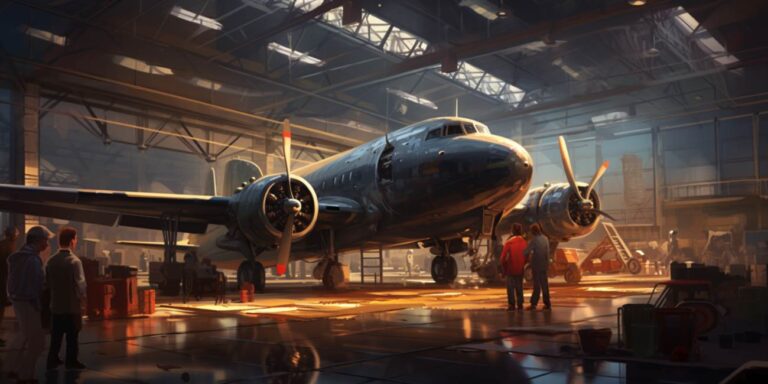For those venturing into the world of aircraft assembly, the monetary aspect is undeniably a significant consideration. The average salary for aircraft assemblers is noteworthy, reflecting the specialized skills and attention to detail required for this demanding job. As of the latest available data, the median annual wage stands at $54,230, providing a stable foundation for a career in aviation.
However, the compensation package for aircraft assemblers isn’t static. It undergoes variations based on several factors. Geographic location plays a crucial role, with assemblers in certain regions earning higher salaries due to the demand-supply dynamics in the aviation industry. Additionally, the level of experience brings its own set of perks, as seasoned aircraft assemblers command higher pay grades.
The aerospace industry, known for its innovation and cutting-edge technology, offers competitive salaries to attract and retain skilled professionals. Beyond the basic salary, benefits and bonuses further sweeten the deal. Health insurance, retirement plans, and performance-based bonuses contribute to the overall financial package, making a career in aircraft assembly even more appealing.
Breaking down the salary structure of aircraft assemblers, it’s essential to consider the various stages of their career. Entry-level positions may offer a starting salary of around $40,000, providing a stepping stone for individuals eager to make their mark in the aerospace domain. With experience, the pay scale ascends, and seasoned assemblers with years of expertise can earn well above the median.
The educational background of aircraft assemblers also influences their earning potential. Those with specialized training, certifications, or degrees in aviation technology may find themselves at the upper echelons of the salary spectrum. The industry recognizes and rewards continuous learning and skill enhancement, opening doors for career advancement and higher remuneration.
It’s worth noting that aircraft assemblers often work in highly regulated environments, ensuring compliance with safety standards and protocols. This aspect of their job is reflected in the meticulous nature of their work, where precision is non-negotiable. As a result, the job outlook for aircraft assemblers remains positive, with the industry’s growth contributing to sustained demand for skilled professionals.
Aircraft assemblers job duties and daily tasks
Working as an aircraft assembler involves a diverse range of duties and tasks that require precision, attention to detail, and a deep understanding of aerospace engineering. These skilled professionals play a crucial role in the production process of aircraft, ensuring that every component is meticulously assembled to meet strict safety and quality standards.
Job duties for aircraft assemblers encompass a variety of responsibilities. These professionals are typically involved in reading and interpreting engineering drawings and blueprints, which serve as the guiding documents for assembling aircraft components. The ability to understand complex schematics is a fundamental skill in this role.
One of the primary tasks of an aircraft assembler is the assembly of structural components. This involves putting together the framework of the aircraft, including the fuselage, wings, and tail sections. Assemblers must use a variety of tools, such as drills, rivet guns, and welding equipment, to join metal and composite materials with precision.
Installing systems and components is another critical aspect of the job. Aircraft assemblers are responsible for integrating engines, avionics, landing gear, and other essential systems into the aircraft structure. This requires a comprehensive understanding of the aircraft’s design and functionality.
Ensuring quality control is paramount in the aircraft assembly process. Assemblers meticulously inspect each component for defects, inaccuracies, or irregularities. They use measuring tools and testing equipment to verify that the assembled parts meet the specified tolerances and performance standards.
Collaboration is a key element of the job. Aircraft assemblers often work closely with other professionals, including engineers, designers, and quality control inspectors, to address any issues that may arise during the assembly process. Effective communication and teamwork are crucial to ensuring the seamless integration of all components.
Additionally, adhering to safety protocols is a non-negotiable aspect of the job. Aircraft assemblers must follow strict safety guidelines to minimize the risk of accidents and ensure a secure working environment. This includes the proper use of personal protective equipment and adherence to established safety procedures.
What education and qualifications are required for aircraft assemblers
Embarking on a career as an aircraft assembler requires a unique blend of training, skills, and a solid foundation in education. These professionals play a crucial role in the aviation industry, ensuring that aircraft are meticulously assembled to meet stringent safety and performance standards.
Aspiring aircraft assemblers typically begin their journey by obtaining a high school diploma or equivalent. However, for those with a passion for aviation, enrolling in an aviation high school can provide specialized education tailored to the industry’s demands. These schools offer a curriculum that combines traditional academic subjects with a focus on aviation-related coursework.
While a high school diploma is the minimum requirement, gaining specialized training is essential for those aiming to excel in aircraft assembly. Technical schools and community colleges often offer programs in aviation technology or aerospace manufacturing, providing students with hands-on experience and in-depth knowledge of aircraft systems and components.
Developing the necessary skills for aircraft assembly goes beyond theoretical knowledge. Attention to detail, manual dexterity, and the ability to work in a team are vital attributes. In addition to formal training, aspiring aircraft assemblers often engage in apprenticeships or on-the-job training programs, allowing them to apply their knowledge in real-world scenarios under the guidance of experienced professionals.
The educational journey for aircraft assemblers doesn’t stop with initial training. Continuous learning is crucial in this dynamic field where technology and aviation standards evolve. Many professionals pursue certifications or advanced degrees in aerospace engineering or a related field to stay abreast of industry advancements.
Summing up, the path to becoming a proficient aircraft assembler involves obtaining a solid education foundation, acquiring specialized training in aviation technology, honing essential skills through hands-on experience, and embracing a commitment to lifelong learning in the ever-evolving aviation industry.
What is the future job outlook for aircraft assemblers
The future job outlook for aircraft assemblers is poised for significant growth, driven by a multitude of factors that shape the prospects in this field. As the global aerospace industry continues to soar to new heights, the demand for skilled aircraft assemblers is experiencing an upswing.
One of the key drivers of this positive trend is the continuous advancements in aviation technology. The aerospace sector is witnessing a paradigm shift with the introduction of state-of-the-art materials and cutting-edge manufacturing processes. This, in turn, creates a demand for aircraft assemblers who possess the skills and expertise to work with these innovative technologies.
Moreover, the growing need for more fuel-efficient and environmentally friendly aircraft is another factor contributing to the promising prospects for aircraft assemblers. With sustainability becoming a focal point for the aviation industry, there is a rising requirement for professionals who can contribute to the assembly of eco-friendly aircraft designs.
Companies in the aerospace sector are actively hiring skilled aircraft assemblers to meet the increasing demand for new aircraft. The expansion of existing fleets and the development of next-generation aircraft are driving the creation of numerous openings in this field. It’s not just the traditional aviation giants; even emerging players in the industry are on the lookout for talented professionals to join their teams.
Technological advancements also play a crucial role in shaping the trends in aircraft assembly. The integration of automation and robotics in the assembly process is a notable trend, enhancing efficiency and precision. Aspiring aircraft assemblers with skills in working alongside automated systems find themselves in a favorable position in the job market.
See also:
- How much do aircraft inspectors make: lucrative aviation careers
- Getting into aircraft maintenance as a career path worth considering
- Becoming a licensed aircraft mechanic: education, training and certification
- Where are embraer jets made: the complete manufacturing process
- Cirrus aircraft: impressive aircraft made in the usa





